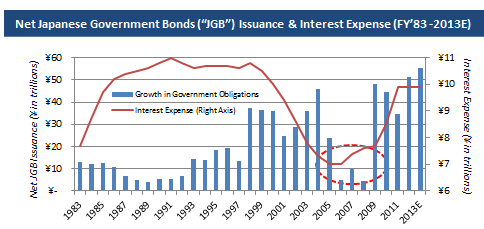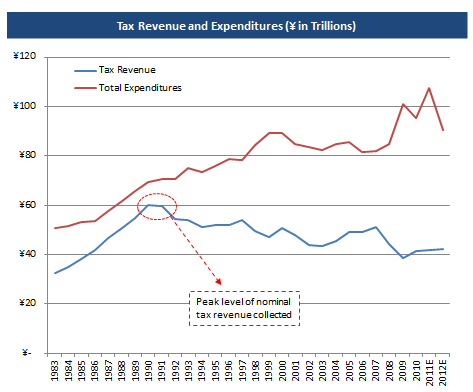There are a lot of smart folks who have been warning that the experimental monetary policies of central bankers globally are not going to end well.
Market observer John Mauldin looks at "Central Bankers Gone Mad":
Central Bankers Gone Mad
When Jonathan Tepper and I wrote Endgame some two years ago, the focus was on Europe, but we clearly detailed how Japan would be the true source of global volatility and instability in just a few years. “A Bug in Search of a Windshield” was the title of the chapter on Japan. This year, I wrote in my forecast issue that 2013 would be “The Year of the Windshield.” For the last two weeks we have focused on the problems facing Japan, and such is the importance of Japan to the world economy that this week we will once again turn to the Land of the Rising Sun. I will try to summarize the situation facing the Japanese. This is critical to understand, because they are determined to share their problems with the world, and we will have no choice but to deal with them. Japan is going to affect your economy and your investments, no matter where you live; Japan is that important.
In bullet-point fashion, let’s summarize the dilemma that faces Abe-san, Kuroda-san, and the other leaders of Japan.

Just for fun, here is a picture of Mr. Ponzi writing a check (courtesy of Geert Noels).

Continue reading here.
Market observer John Mauldin looks at "Central Bankers Gone Mad":
Central Bankers Gone Mad
When Jonathan Tepper and I wrote Endgame some two years ago, the focus was on Europe, but we clearly detailed how Japan would be the true source of global volatility and instability in just a few years. “A Bug in Search of a Windshield” was the title of the chapter on Japan. This year, I wrote in my forecast issue that 2013 would be “The Year of the Windshield.” For the last two weeks we have focused on the problems facing Japan, and such is the importance of Japan to the world economy that this week we will once again turn to the Land of the Rising Sun. I will try to summarize the situation facing the Japanese. This is critical to understand, because they are determined to share their problems with the world, and we will have no choice but to deal with them. Japan is going to affect your economy and your investments, no matter where you live; Japan is that important.
In bullet-point fashion, let’s summarize the dilemma that faces Abe-san, Kuroda-san, and the other leaders of Japan.
- Japan is saddled with a yawning fiscal deficit that, if it were closed too quickly, would plunge the country into immediate and deep recession. The yen would strengthen, and Japan's exports would once again be damaged. Such is the paradoxical outcome if you suddenly decide to live within your means when you have been on a spending binge. The Japanese deficit is close to 10% of GDP. For my US readers, think about what would happen next year if the government cut $1.6 trillion from our budget.
Japan has a GDP that is now close to 500 trillion yen (give or take a few tens of trillions). Their most recent budget calls for Y92.6 trillion in spending, almost evenly divided between Y43.1 trillion financed from tax revenues and Y42.9 trillion from the issuance of new bonds, adding to Japan's massive public-sector debt that already totals nearly Y1 quadrillion. Say that with a straight face: 1 quadrillion. And this massive debt is not a recent phenomenon: it has been accumulating for many years.
Tax revenues have been going down for decades, as the country has been mired in no-growth deflation for 24 years. Revenues are now down to where they were in 1985. By way of comparison, US tax revenues in 1985 were $734 billion (or $1,174 billion in constant 2005 dollars). Last year, US revenues were $2,450 – that is, more than double the 1985 total. (taxpolicycenter.org)
The following chart is courtesy of my friend and Japan expert Kyle Bass at Hayman Capital Management. If this were a stock, would you be a buyer?
- Japanese ten-year interest rates exploded from just above 30 basis points to over 1% at one point in the past month. The Bank of Japan (BOJ) intervened, but rates closed today at 0.85%. Note that they are still down from the 1.3% where they stood two years ago.
- It costs the Japanese government 24% of its revenues just to pay the interest on its debt at current rates. According to my friend Grant Williams (author of Things That Make You Go Hmmm...), if rates rise to just 2.2%, then it will take 80% of revenues to pay the interest. Even at the low current rates, the explosion in Japanese debt has meant that interest rate expense has risen from Y7 trillion to over Y10 trillion. Note in the chart below (also from Kyle) that the Japanese government is now issuing more in bonds than it pays in interest. Somewhere, Charles Ponzi is smiling.

Just for fun, here is a picture of Mr. Ponzi writing a check (courtesy of Geert Noels).

- For 20-plus years, Japanese nominal GDP has barely risen. If your nominal GDP stagnates and you are running large deficits every year, then your debt-to-GDP ratio rises. For Japan, the ration will be a staggering, never-before-seen 245% this year.
Continue reading here.